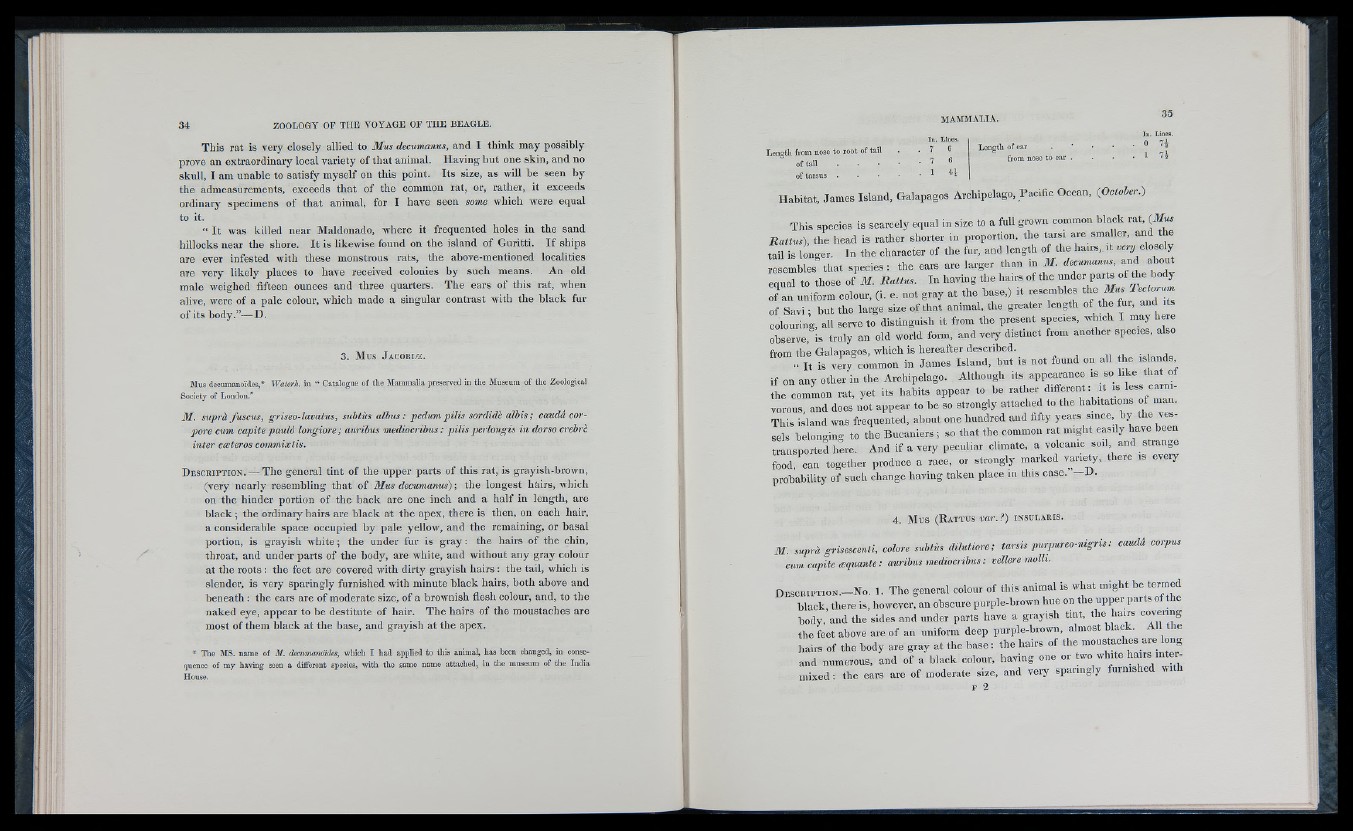
This rat is very closely allied to Mas decumanus, and I think may possibly
prove an extraordinary local variety of that animal. Having but one skin, and no
skull, I am unable to satisfy myself on this point. Its size, as will he seen by
the admeasurements, exceeds that of the common rat, or, rather, it exceeds
ordinary specimens of that animal, for I have seen some which were equal
to it.
“ It was killed near Maldonado, where it frequented holes in the sand
hillocks near the shore. It is likewise found on the island of Guritti. If ships
are ever infested with these monstrous rats, the above-mentioned localities
are very likely places to have received colonies by such means. An old
male weighed fifteen ounces and three quarters. The ears of this rat, when
alive, were of a pale colour, M'hich made a singular contrast with the black fur
of its body.”— D.
3 . Mus J a c o b i/e .
5Ius clecumanoides,* Waterh. in “ Catalogue of the Mammalia preserved in the Museum of the Zoological
Society of London.”
31. suprà fuscus, griseo-lavatus, subtus albus: pedum pilis sordidh albis; candii corpore
cum capite pauld longiore; auribus mediocrihus : pilis perlongis in dorso crebrh
inter coeteros commixtis.
D e s c r ip t io n . — The general tint of the upper parts of this rat, is grayish-brown,
(very nearly resembling that of 3Ius decumanus); the longest hairs, which
on the hinder portion of the back are one inch and a half in length, are
black ; the ordinary hairs are black at the apex, there is then, on each hair,
a considerable space occupied by pale yellow, and the remaining, or basal
portion, is grayish white; the under fur is gray: the hairs of the chin,
throat, and under parts of the body, are white, and without any gray colour
at the roots : the feet are covered with dirty grayish hairs : the tail, which is
slender, is very sparingly furnished with minute black hairs, both above and
beneath : the ears are of moderate size, of a brownish flesh colour, and, to the
naked eye, appear to be destitute of hair. The hairs of the moustaches are
most of them black at the base, and grayish at the apex.
* The MS. name of M. decwmandides, which I had applied to this animal, has been changed, in consequence
of m y having seen a different species, w ith the same name attached, in the museum of tlie India
House.
to root of tail
In. Lines.
7 6
7 6
Length of ear
from nose to ear .
In. Lines.
0 74
Length from nose 1 74
of tail
of tarsus
Habitat, James Island, Galapagos Archipelago, Pacific Ocean, (October.)
This species is scarcely equal in size to a full grown common black rat,
Rattus). the head is rather shorter in proportion, the tarsi are sma ler, and the
tail is longer. In the character of the fur, and length of the hairs, it closely
resembles that species: the ears are larger than in M. decumanus,
equal to those of 31. Rattus. In having the hairs of the under parts of the body
o?an uniform colour, (i. e. not gray at the base.) it resemhles
of Savi; but the large size of that animal, the greater length of the fui, and its
colouring, all serve to distinguish it from the present species, which I may here
observe, is truly an old world form, and very distinct from another species, also
from the Galapagos, which is hereafter described. „ . • , ,
“ It is very common in James Island, hut is not found on all he is ands
if on any other in the Archipelago. Although its appearance is so like that of
the common rat, yet its habits appear to he rather different: it is less carnivorous,
and does not appear to he so strongly attached to the habitations of man.
This island was frequented, about one hundred aud fifty years since, by the vessels
belonging to the Bucaniers ; so that the common rat might easily have been
transported here. And if a very peculiar climate, a volcanic soil
food, can together produce a race, or strongly marked vmiety, there eveiy
probability of such change having taken place in this case, U.
4. Mus ( R a t t u s var. ?) in s u l a r is .
31. suprà grisescenti, colore subtùs dilutiore; tarsis purpureo-nigris : caudâ corpus
cum capite oequante: aurihus mediocrihus: vellere molh.
D e s c b ip t io n . - N o . 1. The general colour of this animal is what might be termed
black, there is, however, an obscure purple-brown hue on the upper parts of the
body, and the sides and under parts have a grayish tint, ‘be hairs
the feet above are of an uniform deep purple-brown, almost black. All the
hairs of the body are gray at the base : the hairs of the moustaches are long
and numerous, and of a black colour, having one or two white hairs intermixed
: the ears are of moderate size, and very sparingly furnished with
F 2